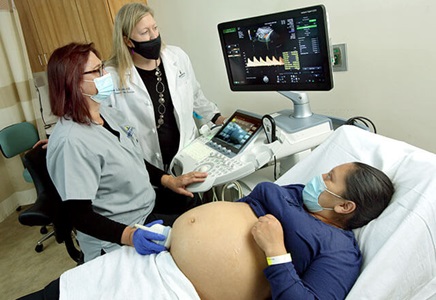Preeclampsia
Preeclampsia is characterized by persistent high blood pressure and other problems in people who are pregnant or who have recently given birth.
What You Need to Know
- Preeclampsia happens in about 5% to 8% of pregnancies. Having it once increases the chances of having it in future pregnancies.
- Complications can include premature birth, fluid in the lungs, bleeding problems, and liver or kidney damage. There is also the risk of seizures, stroke and death of either the mother or the baby.
- Treatment, if necessary, is based on how far along the pregnancy is, and may include induced labor or Caesarean section (C-section).
What is preeclampsia?
Preeclampsia is persistent high blood pressure that happens during pregnancy or after giving birth. It is potentially serious and its complications, such as liver and kidney damage, can threaten the life of mother and baby. Preeclampsia can also cause a decrease in the number of blood cells called platelets and damage to the placenta, the kidneys or liver.
Most cases of preeclampsia occur between the 24th and 27th weeks of pregnancy or soon after giving birth (postpartum preeclampsia), but can occur any time after 20 weeks of pregnancy.
Signs and Symptoms of Preeclampsia
Preeclampsia is diagnosed through signs and symptoms that can appear during pregnancy.
Signs of Preeclampsia
A doctor may suspect preeclampsia and recommend more tests and treatments if you exhibit one or more of the following:
- High blood pressure (hypertension), which often has no symptoms. It is important that pregnant people know their blood pressure and check it regularly.
- Swelling around the eyes, in the face or hands (mild swelling of the feet is normal during many pregnancies)
- Sudden weight gain of more than 3 to 5 pounds in one week
- Protein in your urine, which a doctor can detect with a simple urine test
- Low or lessened output of urine
- Vaginal bleeding
Symptoms of Preeclampsia
Pregnancy can cause many new or unfamiliar sensations in the body, but certain symptoms associated with preeclampsia can put your health at risk. Pregnant people should call their obstetrician right away if they are having preeclampsia symptoms such as:
- A dull, throbbing, migraine-like headache that won’t go away, especially when the headache is accompanied by sensitivity to light
- Nausea or vomiting that shows up suddenly after the midpoint of pregnancy
- Pain in the belly (abdomen), right shoulder or under the ribs on the right side
- Vision changes such as blurred or double vision, flashing lights or spots
- Feeling the baby moving less than usual
Preeclampsia Test
A new blood test for preeclampsia may be able to help identify pregnant people at risk. The test measures a balance of two proteins produced by the placenta. A higher imbalance between the proteins indicates the chances of progressing to preeclampsia.
Although not yet widely available or commonly used, the preeclampsia test will be for those hospitalized for high blood pressure in the 23rd to 35th week of pregnancy. The test is intended to help doctors recommend the best approach to treatment for each patient.

What causes preeclampsia?
The exact causes of preeclampsia are not known. However, preeclampsia can develop from gestational hypertension, defined as high blood pressure (over 140/90) that develops during pregnancy, but without evidence of kidney or liver damage. Gestational hypertension is most common in first pregnancies and in pregnancies with twins or higher order multiples. Women who have had gestational hypertension with one pregnancy are likely to have it again.
Studies have shown that 15% to 25% of women diagnosed with gestational hypertension will develop preeclampsia. This risk is higher for women who have a diagnosis of high blood pressure before pregnancy begins.
Who is at risk for preeclampsia?
While the cause is unknown, pregnant people who are more likely to develop preeclampsia are those who:
- Are Black
- Are experiencing their first pregnancy ever or first pregnancy with a new partner
- Are pregnant with twins, triplets or more
- Are younger than age 20 or older than age 40
- Have had high blood pressure problems during a previous pregnancy
- Have a personal or family history of high blood pressure during pregnancy
- Have certain health problems, such as:
- Diabetes, including gestational diabetes
- Kidney disease
- Immune system conditions such as lupus
Preeclampsia Treatment
Treatment for preeclampsia depends on how severe it is and when it occurs. In general, for:
- Pregnancies of less than 34 weeks: Because the baby may not be developed enough to be born safely, the obstetrician may recommend watching and waiting.
- Pregnancies between weeks 34 and 37: The obstetrician will recommend an individualized approach that is best and safest for mother and baby, including one or more of these therapies:
- Decreased physical exertion
- Hospitalization for observation
- Treatment with intravenous magnesium sulfate to prevent seizures
- Medications to lower blood pressure and prevent a stroke
- Induction of labor if the mother’s or baby’s life is in danger
- Past the 37-week mark: The doctor may provide the option to induce labor or deliver the baby by C-section.
- Postpartum: In most cases, preeclampsia goes away on its own within 48 hours (about two days) after childbirth. But postpartum preeclampsia can occur weeks after the baby is born, and although this is rare, late postpartum preeclampsia can be severe.
Preeclampsia Complications
Most people with preeclampsia will give birth safely and recover. But unrecognized preeclampsia can worsen rapidly and raise the risk of several serious complications.
Eclampsia
Eclampsia is the most severe form of pregnancy-caused high blood pressure, and it can develop from preeclampsia. It causes seizures that can lead to brain damage, and is one of the major causes of maternal death globally. Having eclampsia is a medical emergency that requires treatment at the hospital, medicines and delivery of the baby.
HELLP Syndrome
HELLP stands for hemolysis (breakdown of red blood cells), elevated liver enzymes and low platelets. It is a very serious complication of pregnancy that occurs in about 15% of pregnant people with preeclampsia or eclampsia, especially those who are age 35 and older.
Complications of HELLP syndrome can cause stillbirth or newborn death. HELLP can cause stroke or liver rupture in the pregnant person. Symptoms can include:
- Pain in the stomach or chest
- Shortness of breath and painful, difficult breathing or gasping
- Nausea, vomiting or indigestion, especially after eating
- Persistent headache
- Bleeding
- Pain in shoulders
- Vision changes
- Swollen face or hands
The chance of dying from HELLP syndrome is 25%. Prompt testing, diagnosis and treatment are critical for the health of the mother and baby. Treatment may include emergency delivery of the baby and transfusion of blood cells or plasma.
Additional Complications Affecting the Mother
- Seizures
- Kidney damage or failure (usually reversible)
- Liver problems
- Stroke
- Bleeding problems
- Future risk of heart disease
Additional Complications Affecting the Fetus or Baby
Preeclampsia can cause:
- Slower growth
- Less amniotic fluid than normal (amniotic fluid surrounds and protects the developing fetus)
- Premature birth
- Stillbirth or death soon after being born





